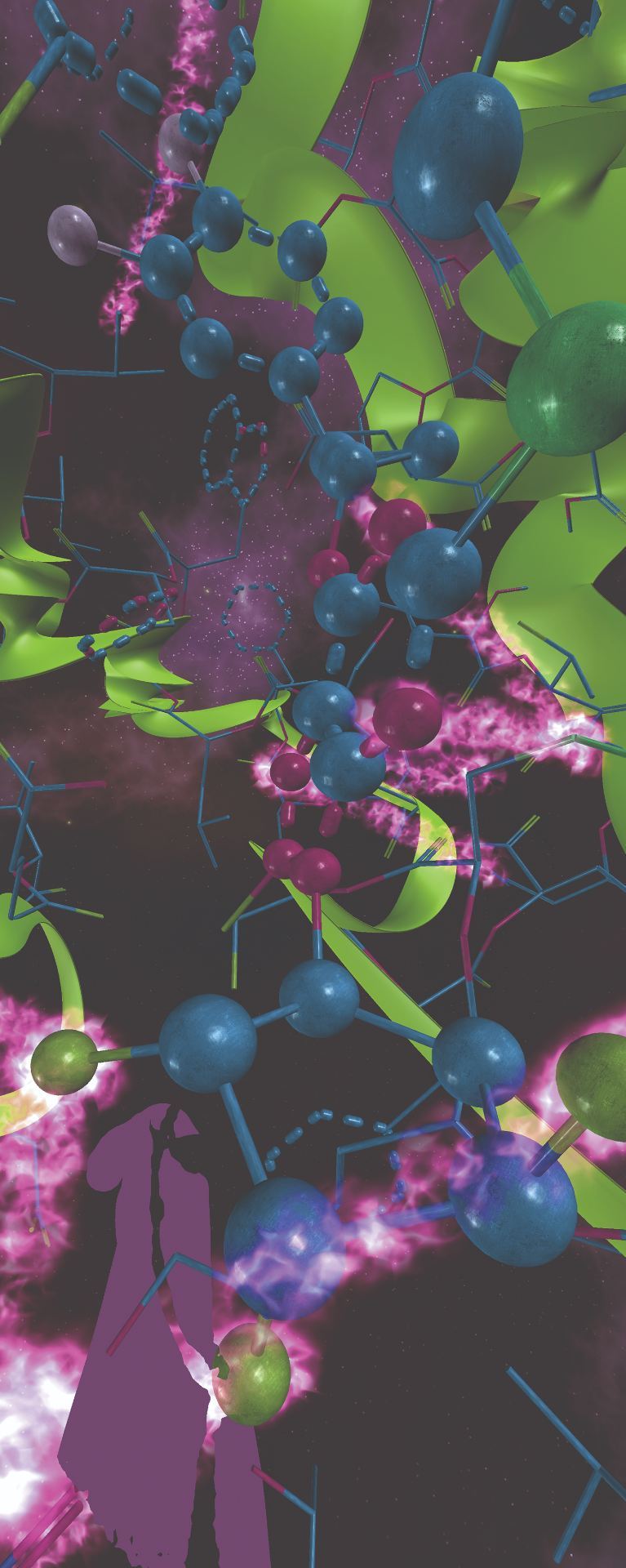
Wandering around the molecular landscape: embracing virtual reality as a research showcasing outreach and teaching tool
Professor Juliet Gerrard, Department of Biology Sciences; Professor Mark Gahegan, Centre for eResearch; Dr Justin O’Sullivan, Senior Research Fellow, Liggins Institute; Matt Pendred, Motion Graphic Artist, Department of Media Production
Virtual reality on campus
Virtual reality in science is an exciting, effective and rapid expanding field in today’s research. Auckland molecular research at the School of Biological Sciences aims to build capability in the use of virtual reality technology for molecular visualisation, i.e. to create an experience which enables the user to actually climb inside a molecule and walk around it. The required hardware was funded by the MacDiarmid Institute, and a workshop is run by PhD student Kyle Webster to build interest in using the technology to showcase research on campus.
The team has run a small pilot study using existing software to provide a proof of concept that is indeed possible to climb inside a virtual molecule. To keep up with the rapid growing technology, a dedicated software developer and a motion graphic designer are part of the Auckland team to connect local and international expertise so that the Auckland molecules are professionally rendered to maximise the impact as a research, teaching and outreach tool.
Application
The team will create awareness on campus of the technology, so that researchers can turn their molecules into virtual reality experiences and stroll around them. In the first instance, the team will use proteins in the Lab from Professor Gerrard and her collaborators as case studies, moving onto the more complex case of Dr O’Sullivan’s complex DNA structures in whole chromosomes. We envisage that many other projects will be nucleated by the programmer, researchers and PhD students who will be excited to turn their 3D data into a virtual reality experience.
Collaboration
Professor Gerrard was introduced to the Vive VR technology at the Googleplex – an international SciFoo Conference – and was able to keep updates of other institutions that are rapid adopters of this technology. For example, Professor Tom Davies, Director of the ARC Centre of Excellence in Convergent Bio-Nano Science and Technology (https://www.cbns.org.au/) and Professor Paul Bonnington from CAVE-2 Centre (http://www.monash.edu/mivp) are some of the more advanced players in the field who have agreed to share their expertise as part of this programmer. More locally, the team have connected with the VR Garage and the Media Design School, where Steve Dorner, Associate Dean (Programme Leader of Bachelor of Art and Design ) is interested in assisting with scaling the technology for large undergraduate audiences (perhaps through augmented reality). This would provide an opportunity to showcase Auckland molecular research at the centre of the virtual reality experience, and tailor it to attract students and researchers to the University of Auckland.
The role of CeR
CeR has an excellent facilities and expertise in visulisation and analytic area. The Centre has been working with researchers across the University including Auckland Bioengineering Institute (ABI), Faculty of Medical and Health Sciences, Population Health, Mathematics, Marine Science, New Zealand Institute for Pacific Research names but a few, to build visual spatial maps, generate animated model, 3D modelling tool etc.
The benefits to the University
The project is linked to the University strategic priorities and provide the following benefits:
- Attracting talented undergraduates and postgraduates throughout NZ and internationally.
- Enhancing the University’s ability to attract externally funded research and in particular, offshore funding.
- Enhancing the student experience, including the experience of international students.
- Enhancing learning and teaching.
- Enhancing the University’s international relationships and standing.

See more case study projects

Our Voices: using innovative techniques to collect, analyse and amplify the lived experiences of young people in Aotearoa

Painting the brain: multiplexed tissue labelling of human brain tissue to facilitate discoveries in neuroanatomy

Detecting anomalous matches in professional sports: a novel approach using advanced anomaly detection techniques

Benefits of linking routine medical records to the GUiNZ longitudinal birth cohort: Childhood injury predictors

Using a virtual machine-based machine learning algorithm to obtain comprehensive behavioural information in an in vivo Alzheimer’s disease model

Mapping livability: the “15-minute city” concept for car-dependent districts in Auckland, New Zealand

Travelling Heads – Measuring Reproducibility and Repeatability of Magnetic Resonance Imaging in Dementia

Novel Subject-Specific Method of Visualising Group Differences from Multiple DTI Metrics without Averaging

Re-assess urban spaces under COVID-19 impact: sensing Auckland social ‘hotspots’ with mobile location data

Aotearoa New Zealand’s changing coastline – Resilience to Nature’s Challenges (National Science Challenge)

Proteins under a computational microscope: designing in-silico strategies to understand and develop molecular functionalities in Life Sciences and Engineering

Coastal image classification and nalysis based on convolutional neural betworks and pattern recognition

Determinants of translation efficiency in the evolutionarily-divergent protist Trichomonas vaginalis

Measuring impact of entrepreneurship activities on students’ mindset, capabilities and entrepreneurial intentions

Using Zebra Finch data and deep learning classification to identify individual bird calls from audio recordings

Automated measurement of intracranial cerebrospinal fluid volume and outcome after endovascular thrombectomy for ischemic stroke

Using simple models to explore complex dynamics: A case study of macomona liliana (wedge-shell) and nutrient variations

Fully coupled thermo-hydro-mechanical modelling of permeability enhancement by the finite element method

Modelling dual reflux pressure swing adsorption (DR-PSA) units for gas separation in natural gas processing

Molecular phylogenetics uses genetic data to reconstruct the evolutionary history of individuals, populations or species

Wandering around the molecular landscape: embracing virtual reality as a research showcasing outreach and teaching tool
























































































































































